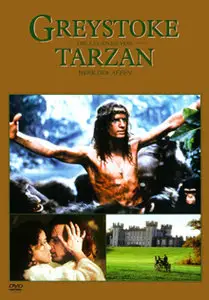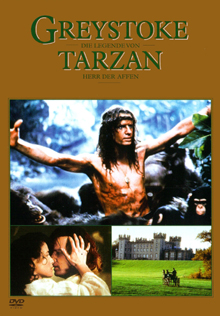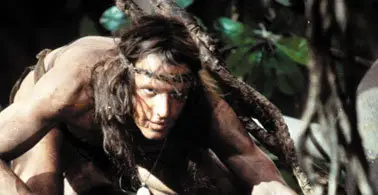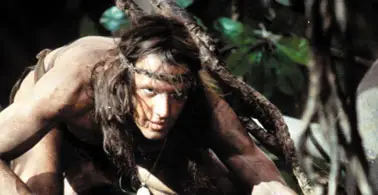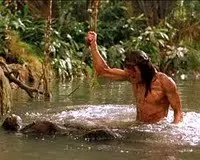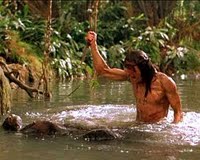: Greystoke – The legend of Tarzan, Lord of the apes – Hugh Hudson (1984)
English | Subtitle: English/French/German/Spanish/Italian and more | 2:11:22 | 1024 x 576 NTSC | DivX | MP3 – 384 kbps | 1530 MB
Genre: Action
English | Subtitle: English/French/German/Spanish/Italian and more | 2:11:22 | 1024 x 576 NTSC | DivX | MP3 – 384 kbps | 1530 MB
Genre: Action
Cast: Ralph Richardson, Ian Holm, James Fox, Christopher Lambert
FROM the most unlikely source material comes the season's most unexpected, most invigorating surprise, ''Greystoke: the Legend of Tarzan, Lord of the Apes,'' a huge, lavishly produced period film that is part adventure, part comedy of manners and part somber melodrama.
Hugh Hudson, director of the Oscar-winning ''Chariots of Fire,'' and his associates have made something much more than a good fantasy. They have discovered reserves of feeling and beauty in the old Edgar Rice Burroughs tales that remained unexplored by Burroughs himself and by the dozens of journeymen who have been cranking out Tarzan movies and television serials over the years.
''Greystoke,'' which opens today at the Criterion and other theaters, is also a little weird, at least as far as Tarzan movies go. It's a highly romantic, Pop variation on the ''wolf boy'' story considered in such austere fashion by Francois Truffaut in ''The Wild Child.'' At the same time, it's an unusually intelligent and serious entertainment for the mass market.
The sheer physical scope of the film, as well as the abrupt, rough, explicit bloodiness of some of the jungle material, have little to do with the ''me Tarzan, you Jane'' fantasies that have been with us virtually since Burroughs published ''Tarzan of the Apes'' in 1914. Burroughs went on to write a couple of dozen sequels that, in turn, served as the inspiration for any number of Tarzan movies featuring everyone from Elmo Lincoln (1918) to Miles O'Keefe (1981), though the late Johnny Weissmuller is the Tarzan most of us remember most vividly.
''Greystoke'' isn't in competition with its predecessors. It's a different order of fiction entirely. Among other things, it doesn't leave much room for sequels.
The fine screenplay, credited to P. H. Vazak, said to be the pseudonym for Robert Towne, who conceived the project, and Michael Austin, is nothing if not comprehensive. It opens in 1885 in Britain, at the great country house - a palace, really - of the sixth Earl of Greystoke (Sir Ralph Richardson), as his son, Lord Jack Clayton, is preparing to leave for Africa, taking with him his pregnant, young wife, Lady Alice.
In the leisurely fashion of 19th-century fiction, the film thus recounts the background of Tarzan, whose parents, the Claytons, are subsequently shipwrecked on the Ivory Coast. There, six months later, Tarzan is born and, on the death of his parents, adopted by a large family of carefully characterized chimpanzees who are loving, short-tempered, extremely protective and given to practical jokes.
In some of its most remarkable footage, ''Greystoke'' shows us Tarzan's growing up from infancy to childhood, adolescence and manhood. Shortly after his adoptive mother is killed by pygmies, Tarzan comes upon a wounded Belgian explorer, Capt. Phillippe D'Arnot (Ian Holm), and nurses him back to health. It is D'Arnot who finally identifies Tarzan and takes him to England, where approximately one-third of the film is set.
People who think of Tarzan movies as being synonymous with the Dark Continent of B-fiction, with playful chimpanzees as comic relief, with lost cities of gold and elephants' graveyards, may not be pleased by the long sojourn of ''Greystoke'' in Edwardian England.
They may also be shocked that the name ''Tarzan'' is never spoken in the movie. Until D'Arnot identifies him, he is not called anything by the apes, who communicate in a series of grunts, growls, beeps and whinnies not translated by English subtitles. Not until he is home at Greystoke does he receive a name, Lord John Clayton, heir to his grandfather's title.
The most inspired invention of Mr. Hudson and the writers is the creation of the character of the old earl who, as played by Sir Ralph in one of his most moving and wise performances, dominates the film. That this was to be Sir Ralph's last film performance before his death makes it all the more moving, though it would have been one of the highlights of his film career in any case.
Almost as good is Mr. Holm, nominated for an Oscar for his work in ''Chariots of Fire,'' as the man who, with patience, humor and understanding, introduces Tarzan to the spoken language - first French, then English - and the ways of civilized society.
This Tarzan's Jane is the old earl's American ward, charmingly played by Andie MacDowell, who abandons her elegant English suitor (James Fox) to fall into a discreet affair with Tarzan at Greystoke. One of the film's most offbeat and funny moments is when Tarzan - apelike, on all fours - sneaks into Jane's bedroom late one night to consummate his courtship. Will he tear her clothes off, chew her neck or indulge in some other mating practice frowned upon by upper-crust Edwardians? The audience has a right to be genuinely concerned.
A new actor named Christopher Lambert, born of French parents in New York and raised in Switzerland, is very good as the long-lost heir, of whom it can be asked, ''You can take the English lord out of the jungle, but can you take the jungle out of the English lord?''
Mr. Lambert, a handsome young man with strong, brooding features, is remarkably believable and affecting both as the naked ape of Africa and then as the uncomfortable aristocrat, who tries desperately to fit in with his new family. That this Tarzan is supposed to be a great mimic provides the movie with some of its comedy as well as with its very real pathos.
The film's penultimate sequence, in which Tarzan goes berserk after an unfortunate encounter with an old African friend at London's Natural History Museum, packs an emotional wallop rare even in far more sober- sided movies.
The African sequences, shot in Cameroon, are of stunning, steamy beauty, but no more effective than the British locations, including the old earl's vast estate, which is made up of three of Britain's greatest houses, including Blenheim. John Alcott's photography provides a visual equivalent to the film's stately narrative style, full of majestic camera movements that suggest something of what we take to have been the pace of the Edwardian era.
Mention should also be made of the work of Rick Baker, who designed the ape makeup; Peter Elliot, who is listed as ''primate choreographer,'' and Roger Fouts, ''primate consultant.'' Real chimpanzees and small human actors in champanzee suits are so effectively integrated that, I suspect, only a sharp-eyed, fault-finding chimp could tell which is which.
''Greystoke'' runs for something more than two hours, but there's not a dull moment in the film. However, there are indications at times that the original footage has been truncated, which sometimes results in major scenes being played without a proper buildup.
These aren't reservations, but observations. ''Greystoke'' is one of the most thoroughly enjoyable films of its kind I've ever seen.
RapidShare:
Part 1
Part 2
Part 3
Part 4
Part 5
Part 6
Part 7
Part 8
Part 9
Part 10
Part 11
Part 12
Part 13
Part 14
Part 15
Part 16
Part 17
Part 18
Part 1
Part 2
Part 3
Part 4
Part 5
Part 6
Part 7
Part 8
Part 9
Part 10
Part 11
Part 12
Part 13
Part 14
Part 15
Part 16
Part 17
Part 18
PW: malamute


